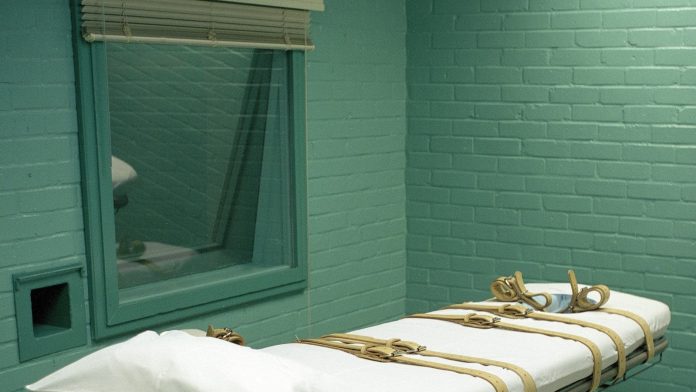The Last Breath in Florida: A Reflection on Justice, Memory, and the Death Penalty’s Place in Modern America
On a humid evening in Florida, the sterile walls of the state penitentiary bore silent witness to the final moments of 67-year-old Kayle Bates. Convicted over four decades ago for a harrowing crime—the abduction and brutal murder of 24-year-old Janet Renee White—Bates was put to death by lethal injection, closing a long and painful chapter in a story that still reverberates far beyond the courtroom walls. As the clock struck 6:17 pm local time on a day marked by solemnity and controversy, a nation once again found itself wrestling with the weight of capital punishment.
A Crime Frozen in Time, a Family’s Enduring Wound
In 1982, the sleepy town of Lynn Haven, nestled in the coastal expanses of Florida, was shattered by an act of unthinkable violence. Janet Renee White, a young woman whose quiet dignity and ambition belied her everyday routine, had returned from lunch at her insurance company office when her nightmare began. Kayle Bates, later found guilty, forcefully abducted her, and the serene woods that fringed the town became the final, tragic stage for their collision of fate.
Janet was just twenty-four—full of potential, hopes, and dreams tragically cut short. To the community, she was a symbol of fragility painfully exposed, a stark reminder of how quickly life can shift from normalcy to nightmare.
“We still feel her absence every day,” a lifelong Lynn Haven resident and friend of Janet’s family confided, voice thick with emotion. “It’s not just her life that was taken, but all the tomorrows we should have shared with her.”
The End of a Long Road: Justice or Closure?
Bates was sentenced to death in 1983, and after decades of legal battles, appeals, and delays typical in the intricate machinery of the American justice system, his execution was carried out in 2025. His death marked the 29th execution in the United States this year—the highest number since 2014, when 35 inmates were put to death.
Florida, where Bates met his end, has taken a grim lead this year with 10 executions—the largest tally of any state. The methods employed have ranged from the widely used lethal injection to other, more controversial means such as firing squads and even nitrogen hypoxia—a strikingly modern and experimental method involving nitrogen gas-induced asphyxiation.
Nitrogen Hypoxia: The New Frontier in Capital Punishment?
While the notion of using nitrogen gas to end lives may sound clinical, it has stirred heated debates. United Nations human rights experts have condemned this method, describing it as cruel and inhumane—a cold mechanization of death under the guise of innovation.
“In the rush to find painless ways to execute, we risk losing sight of human dignity and the core ethical questions this punishment entails,” says Dr. Elena Ramirez, a leading human rights advocate. “When does the pursuit of efficiency exceed acceptable morality?”
The Divided Landscape of Capital Punishment in America
The American tapestry of justice is as patchworked as its geography. While some states like Florida press on with executions, 23 states have abolished the death penalty outright, and an additional three—California, Oregon, and Pennsylvania—maintain moratoriums, halting executions in an uneasy pause filled with ongoing debate.
Public opinion remains deeply divided. For some, the death penalty is a necessary, albeit severe, tool to deliver justice and deter the most heinous crimes. For others, it’s a relic of an era long passed—a system rife with the dangers of miscarriages of justice, racial bias, and moral quandaries.
President Donald Trump, a vocal supporter during his administration, championed an expansion of the death penalty, calling for its use against “the vilest crimes.” His stance reflected a persistent strand of American ideology—that retributive justice can coexist with the nation’s commitment to human rights and rehabilitation.
Numbers and Nuances
- 29 executions have been carried out across the U.S. in 2025, the highest annual number since 2014.
- Methods include lethal injection (24), firing squad (2), and nitrogen hypoxia (3).
- Florida has accounted for a third of executions this year.
- More than half of U.S. states have abolished capital punishment in some form.
Beyond the Headlines: What Lies Beneath?
Beyond the grim statistics and courtroom dramas lies a profound question that society often hesitates to ask: Does justice end with death, or does it demand deeper reconciliation? For Janet White’s family, the execution may offer a formal closure, but it doesn’t erase the seed of grief planted decades ago.
“No sentence can bring Janet back or soothe the ache,” echoes a local counselor who has worked with victims’ families in Bay County. “True healing comes from remembering, telling stories, and building communities that don’t allow such tragedies.
For Kayle Bates, the decades behind bars were marked by the quiet unraveling of a life ended by a chain of desperate acts. Was the death penalty justice served, or another chapter in a cycle of violence?
Inviting Reflection: What Does Justice Mean Today?
Dear reader, as you sit with this story—the slow, inexorable march toward finality in a case that spans generations—what do you make of justice? Is it retribution, restoration, protection, or something else entirely? In an age eager to innovate with new forms of execution yet wary of mistakes past, what does the death penalty say about us as a global community?
In cities from Lynn Haven to London, from New York to Nairobi, the questions resonate: How do we honor victims like Janet Renee White? How can we ensure that the justice system serves all with fairness, compassion, and wisdom? And, above all, can a society thrive when it carries the burden of sanctioned death?
A World in Transition
With international pressure mounting and ethical debates intensifying, the death penalty sits at a crossroads. The future may well look different from the past—a future where accountability coexists with dignity, where healing takes precedence over vengeance.
Until then, every execution is a reminder—a mirror reflecting our deepest fears, hopes, and the fragile thread that binds humanity. As we close this chapter in Florida’s complex narrative, perhaps it’s not just a story about one man or one woman, but about all of us engaged in the relentless quest for justice and mercy.










